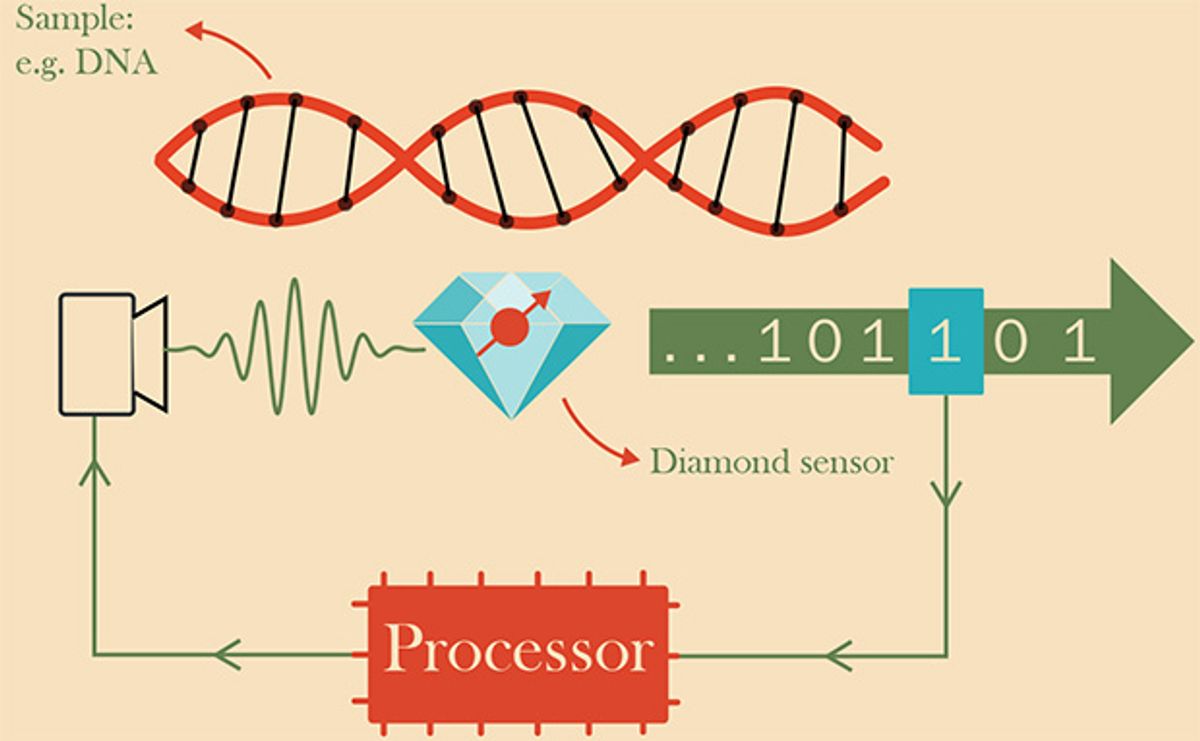We know that electrons have spin. And researchers think that the spin of single electrons trapped in nitrogen vacancy centers in diamond might be used to store qubits in future quantum computers. They’ll use light and microwave pulses to control the electron’s spin—either up or down—read it out. However, because spin is a quantum property, as soon as any measurement is made in order to determine the strength of the magnetic field, the spin switches from superposition into either one of the two possible spin states. But by repeating the measurement multiple times and looking at the distribution of up and down spins, it is possible to estimate the magnetic field strength using statistics.
Researchers at Delft University of Technology in the Netherlands and Macquarie University in Sydney, Australia, have developed a method that boosts the sensitivity of the repeated measurements by using a feedback loop. After each spin determination, it adjusts the measurement settings for the next measurement, resulting in a sensitivity that is 100 times as high as that of earlier experiments. The researchers published the design of an “intelligent” quantum sensor controlled by a microprocessor in last week's Nature Nanotechnology.
If an electron is brought into a magnetic field, it undergoes a Zeeman interaction, says Machiel Blok, a physicist at Delft University of Technology who participated in the research. Blok explains that it’s a phenomenon similar to the splitting of spectral lines observed in the sun's atmosphere that is caused by the sun's magnetic field. He added that:
To measure this interaction, we use a technique called Ramsey interferometry, where we first prepare with a microwave pulse a superposition between the two spin levels. The energy difference between these spin levels depends on the static magnetic field that is present. This can be read out by the spin—that is, how much is in one state, and how much is in the other state. This we do optically; we can get a resonant excitation of the spin, depending on the spin state. As a result, we get fluorescence if it was in one spin state, and no fluorescence if it was in the other spin state.
The experiment is repeated multiple times with a preset series of different sensing times whereby the electron is coaxed into a different quantum state each time and allowed to interact with the magnetic field. The magnetic field affects the proportion of these two states, which the researchers can indicate with a series of ones and zeros. The ratio of zeros to ones is an indication of the strength of the magnetic field.
Up to that point, the methodology of the Delft researchers is no different than earlier research using spins to measure magnetic field strength. But where the methods diverge is that, with each subsequent readout of the electron’s quantum state, the measurement is further refined using Bayesian statistics based on the spin readouts that came before. “By looking at the outcome of each experiment, using Bayesian statistics, you can tune the next step of the experiment, which allows the experimental setup to focus quickly on a better estimate of the magnetic field,” says Blok.
Blok and his collaborators used a commercially-available programmable microprocessor to collect the measurement results in real time—but one that performs the Bayesian update itself. “We programmed the chip so that it can do this efficiently, and this increased the accuracy of the measurement substantially,” says Blok.
Although very weak magnetic fields can be measured with SQUIDs, using electron spins has an interesting advantage: spatial resolution. The spatial resolution of SQUIDs, Blok explains, is limited by the size of the loop, which is in the order of a micrometer or even larger. “Our single-spin sensors, since they are an atomic defect, can, in principle, be of nanometer or subnanometer resolution,” says Blok. To put that size in context, diamond nanocrystals containing nitrogen vacancy centers can be introduced in living single cells, says Blok.



